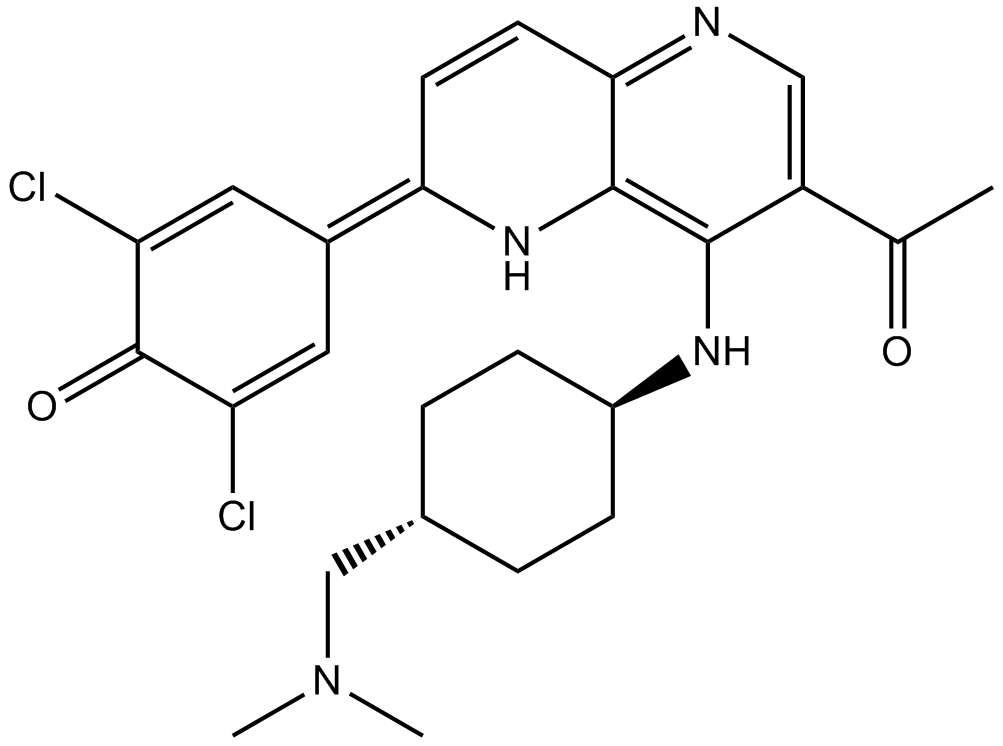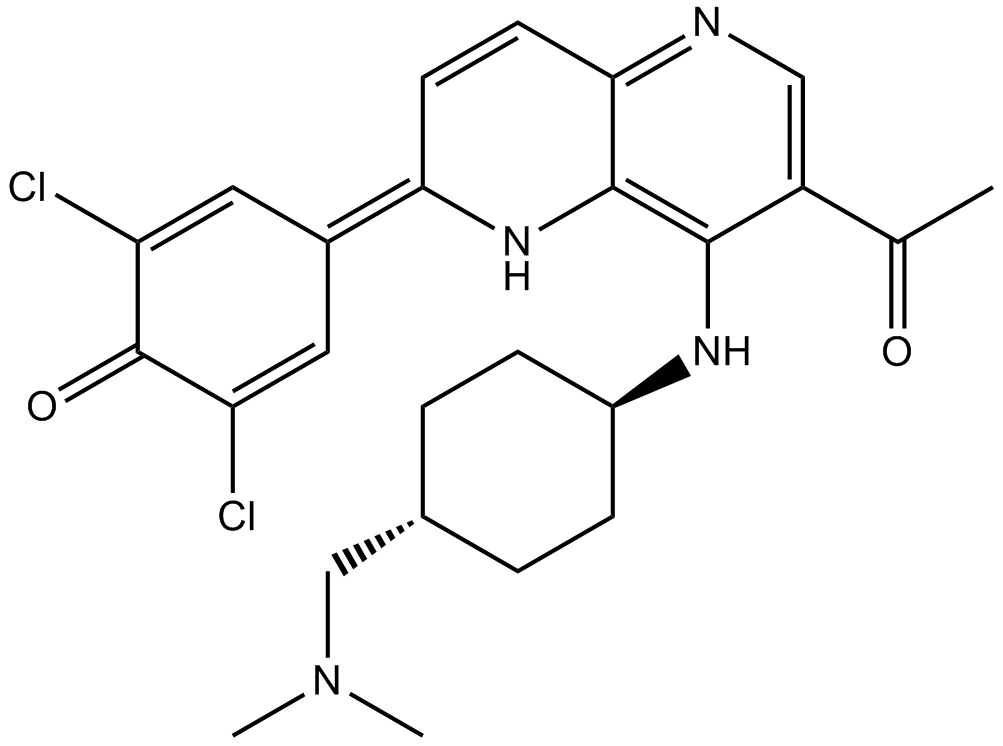OTSSP167
OTSSP167 is an inhibitor of maternal embryonic leucine zipper kinase (MELK) with IC50 value of 0.41nM [1].
MELK is a member of the AMPK serine/threonine kinase family and is involved in the mammalian embryonic development. It plays roles in cancer cell growth and formation or maintenance of cancer stem cells. OTSSP167 is a small-molecule inhibitor and can inhibit MELK’s activity effectively and selectively. OTSSP167 inhibits cell proliferation of a variety of cancer cell lines including A549, T47D, DU4475 and 22Rv1. The IC50 values are 6.7nM, 4.3nM, 2.3nM and 6nM, respectively. In mice bearing MDA-MB-231 xenograft, administration of OTSSP167 inhibits 70% tumor growth at dose of 20 mg/kg. Besides that, OTSSP167 is also found to have effects on PSMA1 and DBNL which are the novel substrates of MELK. It inhibits the phosphorylation of PSMA1 and DBNL causes the subsequent suppression of mammosphere formation [1].
References:
[1] Chung S, Suzuki H, Miyamoto T, et al. Development of an orally-administrative MELK-targeting inhibitor that suppresses the growth of various types of human cancer. Oncotarget, 2012, 3(12): 1629.
| Physical Appearance | A solid |
| Storage | Store at -20°C |
| M.Wt | 487.42 |
| Cas No. | 1431697-89-0 |
| Formula | C25H28Cl2N4O2 |
| Solubility | insoluble in DMSO; insoluble in H2O; insoluble in EtOH |
| Chemical Name | 4-[7-acetyl-8-[[4-[(dimethylamino)methyl]cyclohexyl]amino]-1H-1,5-naphthyridin-2-ylidene]-2,6-dichlorocyclohexa-2,5-dien-1-one |
| SDF | Download SDF |
| Canonical SMILES | CC(c1cnc(C=CC(N2)=C(C=C(C3=O)Cl)C=C3Cl)c2c1NC1CCC(CN(C)C)CC1)=O |
| Shipping Condition | Small Molecules with Blue Ice, Modified Nucleotides with Dry Ice. |
| General tips | We do not recommend long-term storage for the solution, please use it up soon. |
| Cell experiment [1]: | |
|
Cell lines |
A549, T47D, DU4475, and 22Rv1 cancer cells |
|
Preparation method |
Limited soluble in DMSO. General tips for obtaining a higher concentration: Please warm the tube at 37 ℃ for 10 minutes and/or shake it in the ultrasonic bath for a while. Stock solution can be stored below -20℃ for several months. |
|
Reacting condition |
30 μM, 37 °C |
|
Applications |
OTSSP167 inhibited A549 (lung), T47D (breast), DU4475 (breast), and 22Rv1 (prostate) cancer cells with the IC50 values of 6.7, 4.3, 2.3, and 6.0 nM, respectively. OTSSP167 inhibited the phosphorylation of PSMA1 and DBNL. OTSSP167 suppressed mammosphere formation of breast cancer cells through the inhibition of PSMA1 phosphorylation. |
| Animal experiment [1]: | |
|
Animal models |
Mice bearing MDA-MB-231 xenografts, mice carrying A549 (lung cancer) xenografts |
|
Dosage form |
Intravenous administration, 20 mg/kg, once every two days; Oral administration, 10 mg/kg once a day |
|
Application |
In mice bearing MDA-MB-231 xenografts, intravenous administration of OTSSP167 at 20 mg/kg once every two days resulted in tumor growth inhibition (TGI) of 73%. Oral administration at 10 mg/kg once a day revealed TGI of 72%. In mice carrying A549 (lung cancer) xenografts, treatment with 1, 5, and 10 mg/kg once a day of OTSSP167 by intravenous administration revealed TGI of 51, 91, and 108%, respectively and those by oral administration of 5 and 10 mg/kg once a day revealed TGI of 95 and 124%, respectively. In DU145 (prostate cancer) and MIAPaCa-2 (pancreatic cancer) xenograft models, oral administration of 10 mg/kg once a day resulted in TGI of 106 and 87%, respectively. |
|
Other notes |
Please test the solubility of all compounds indoor, and the actual solubility may slightly differ with the theoretical value. This is caused by an experimental system error and it is normal. |
|
References: [1]. Chung S, Suzuki H, Miyamoto T, et al. Development of an orally-administrative MELK-targeting inhibitor that suppresses the growth of various types of human cancer[J]. Oncotarget, 2012, 3(12): 1629. | |
| Description | OTSSP167 is an inhibitor of maternal embryonic leucine zipper kinase (MELK) with IC50 value of 0.41nM . | |||||
| Targets | MELK | |||||
| IC50 | 0.41nM | |||||
Quality Control & MSDS
- View current batch:
Chemical structure









